博文
Metro-NorthRailroad线过Harlem 河抵第125街一瞥
|||
Metro-NorthRailroad线过Harlem 河抵第125街一瞥
黄安年文 黄安年的博客/2015年7月14日清晨,傍晚北京时间发布
曼哈顿岛为Harlem 河、East河、Hudson河所围, Metro-North Railroad驶入曼哈顿岛的GrandCentral Terminal 需要跨越Harlem 河才能够抵达第125街,然后驶入目的地Grand Central Terminal。
照片17张是7月11日上午列车驶过Harlem 河桥前后随机拍摄的。
1,

2,

3,
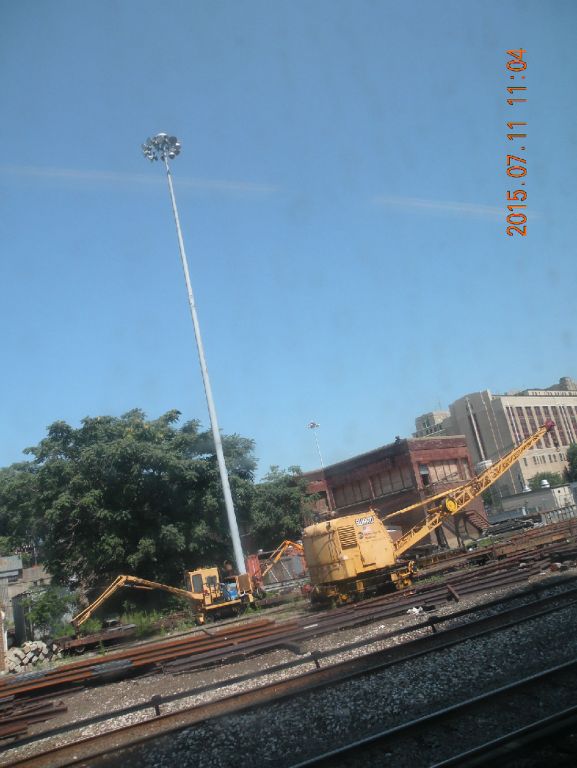
4,
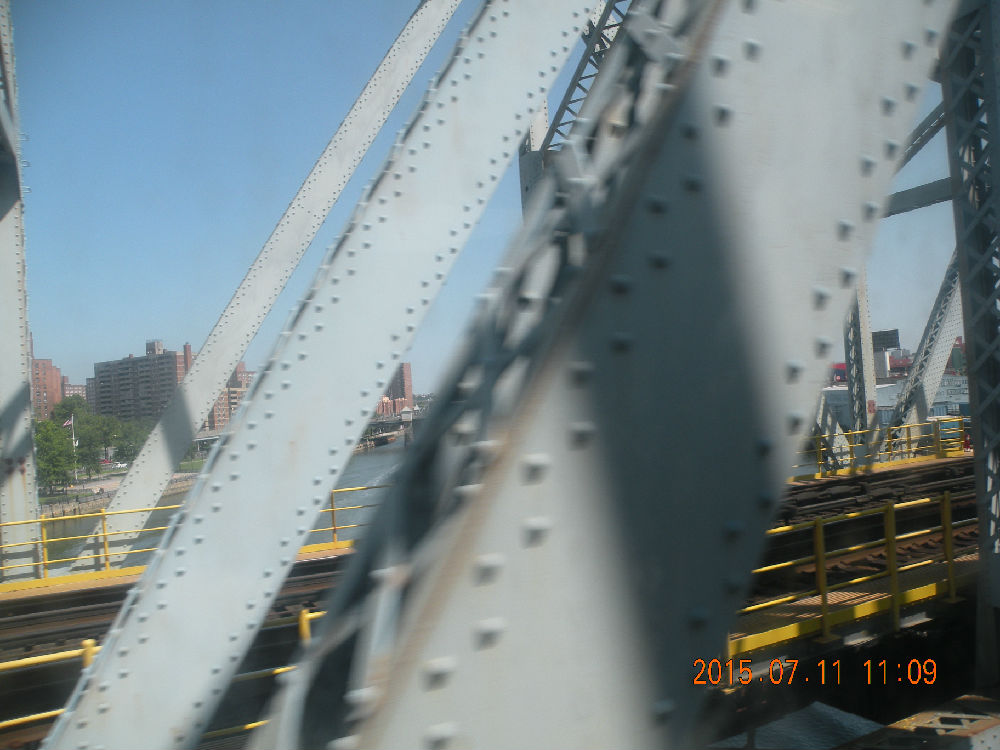
5,
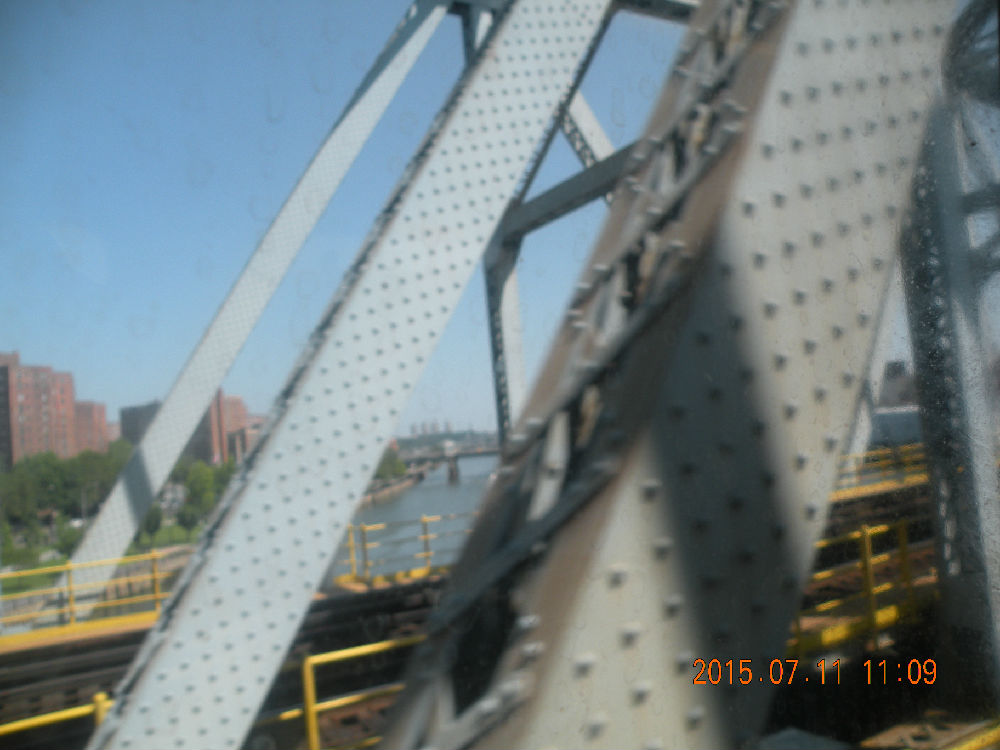
6,
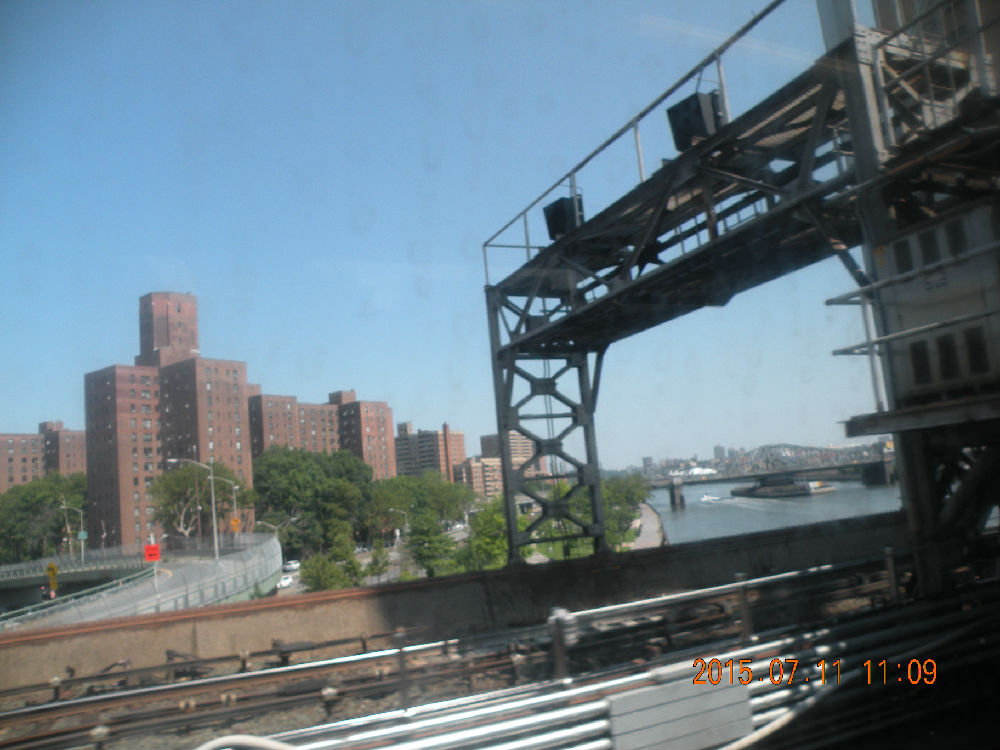
7,

8,
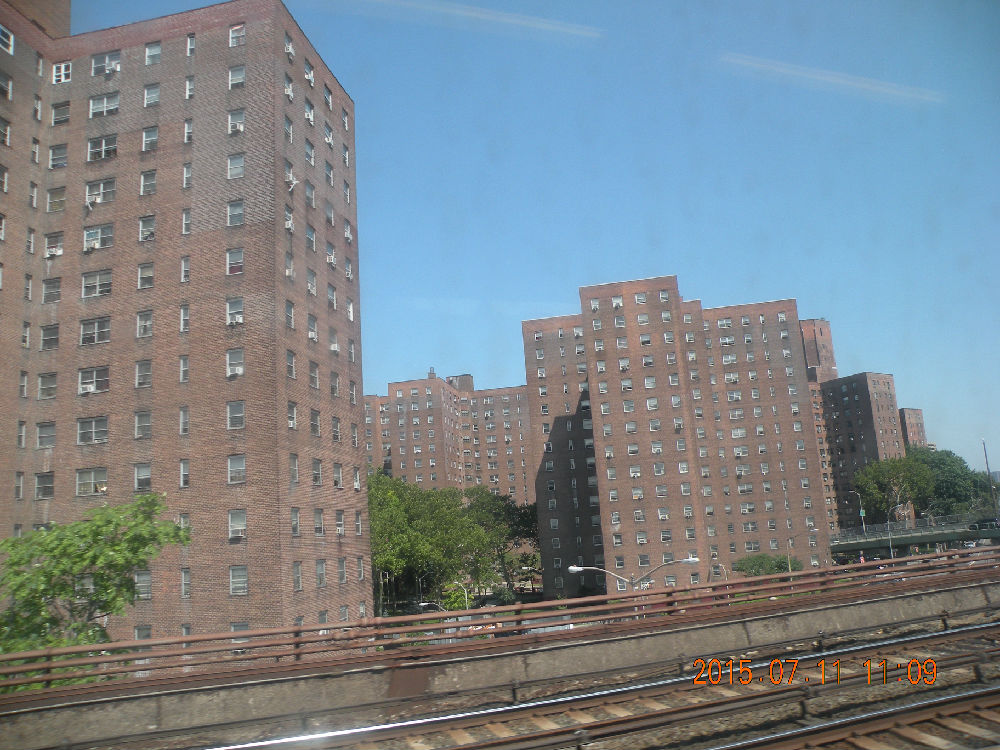
9,
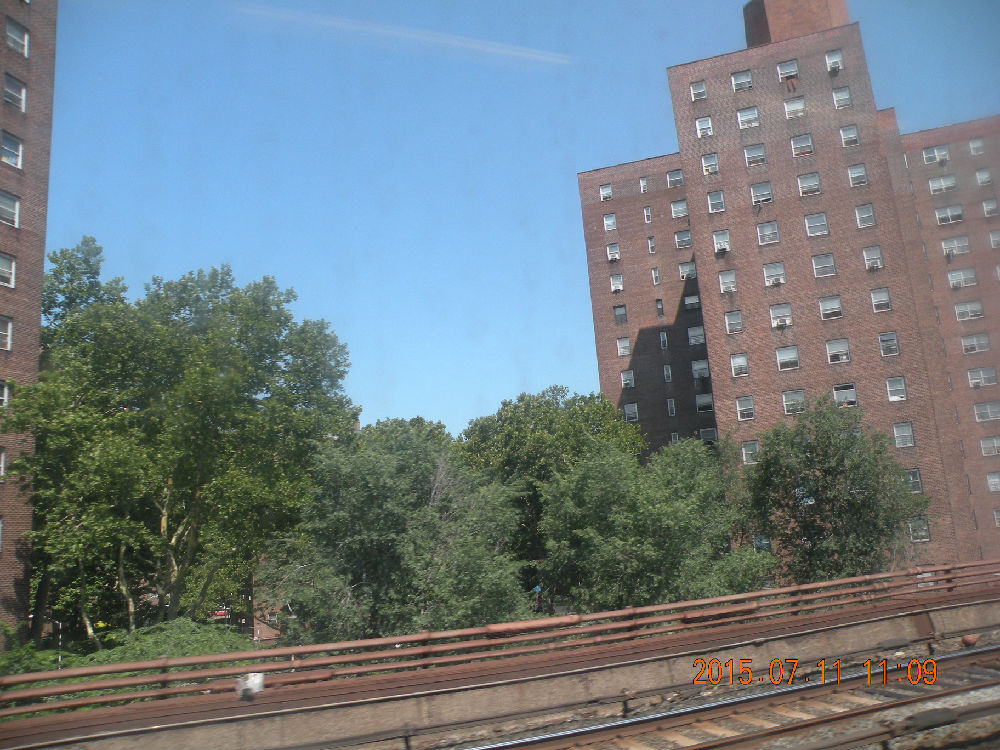
10,

11,
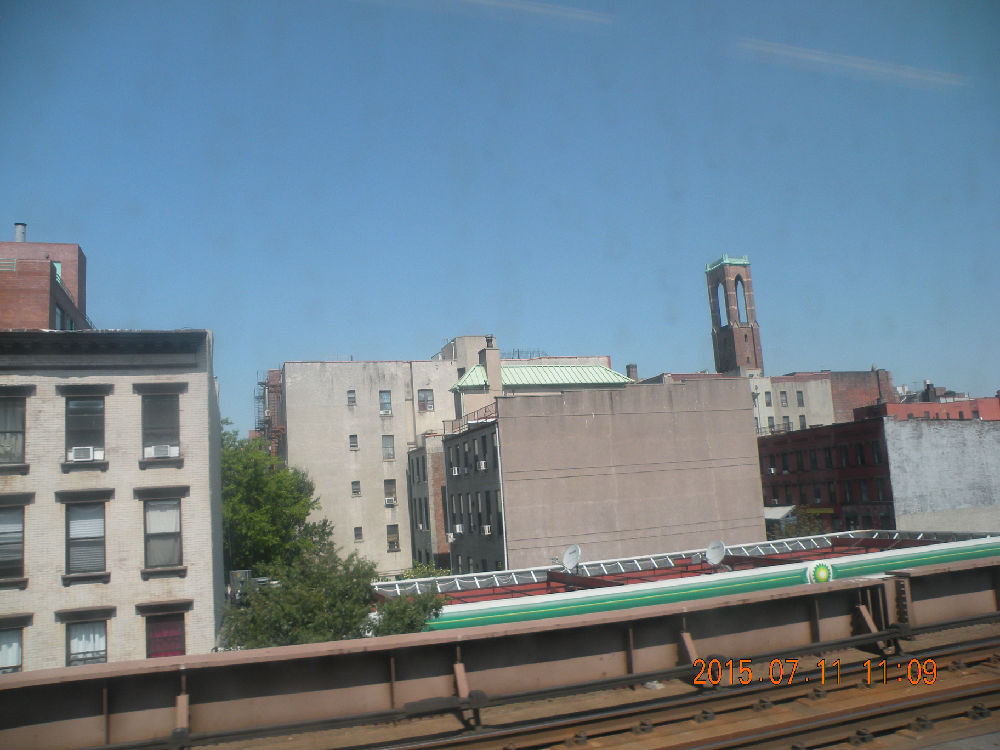
12,
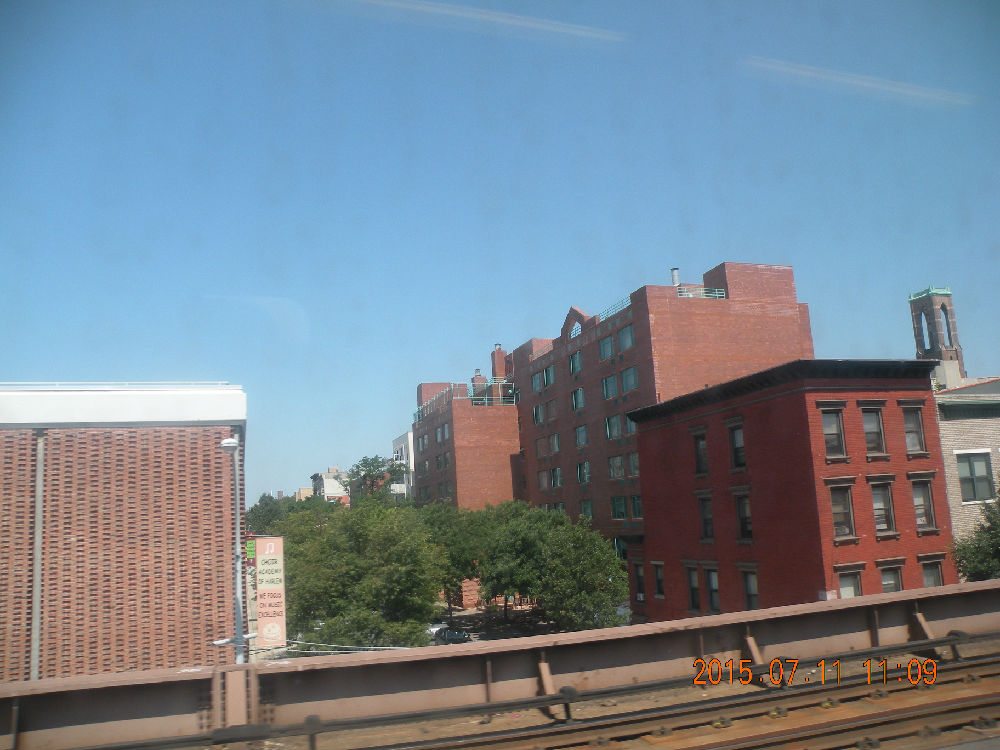
13,
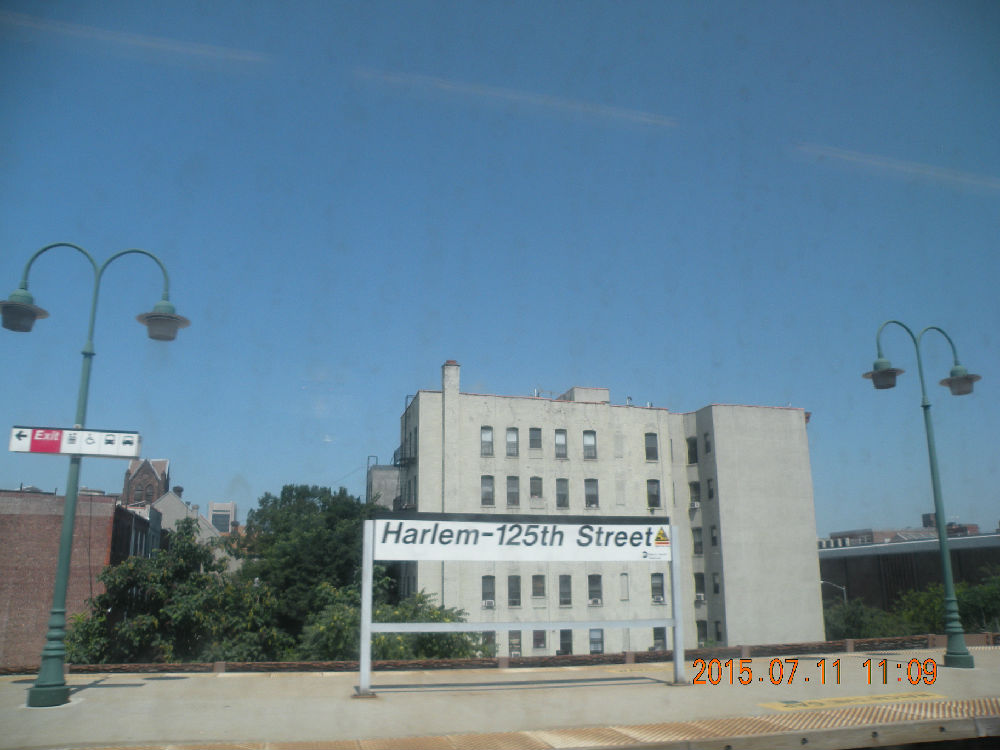
14,
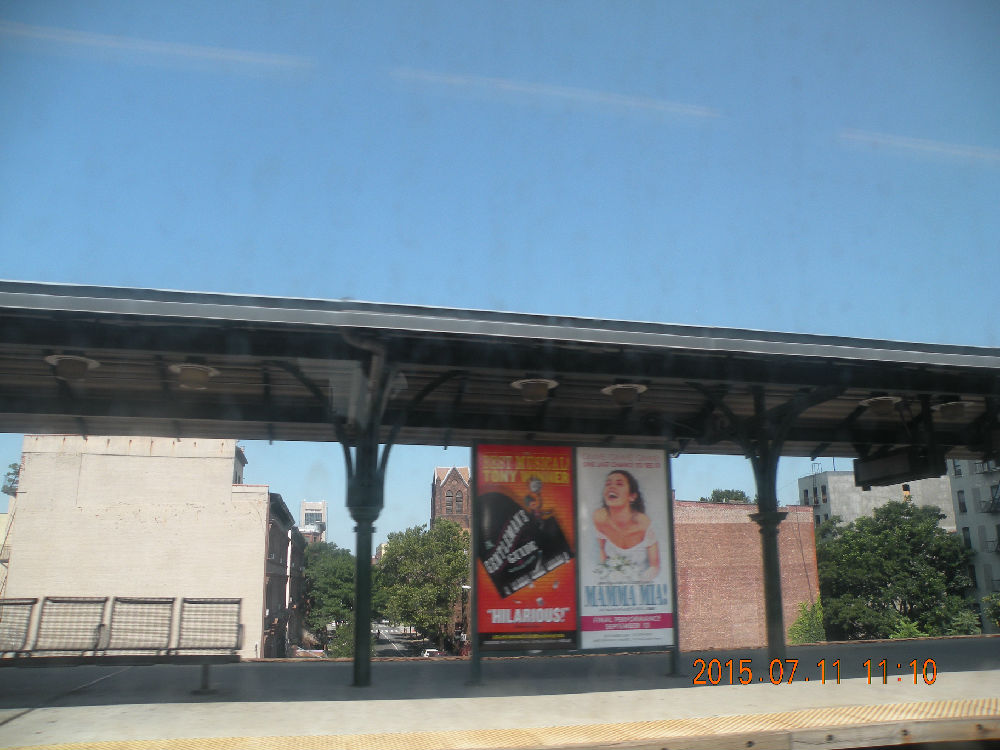
15,

16,

17,
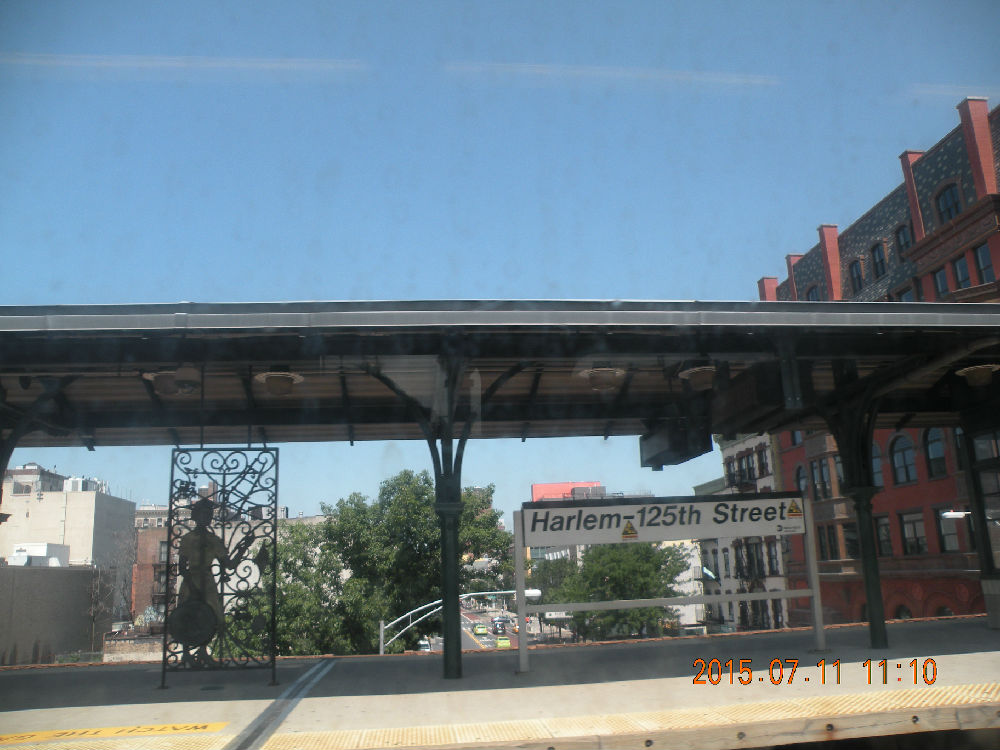
*******************************
Harlem River
From Wikipedia, the free encyclopedia
Jump to: navigation,search
See also: Geography and environment ofNew York City
The combination of the Harlem River, Harlem River Ship Canal, and Spuyten Duyvil Creek, shown in red, form asingle channel between the Bronx and Manhattanin New York City.Today, it's all considered the Harlem River.
The Harlem River is a navigable tidal estuary in NewYork City, United States that flows north from the East Rivertowards the Hudson River. There it joins the Harlem River Ship Canal and Spuyten Duyvil Creek to form an 8 mile(13 km) straitseparating the boroughs of Manhattanand theBronx. Today, the confluence of the three is referred to simply as the Harlem River.
The construction of the ship canal in 1895 and its subsequent in-filling in1914 caused a small portion of Manhattan, Marble Hill, to be isolated on the Bronx side of the river.
Geology and geography
The Henry Hudson Bridge crosses the waterway at itswest end.
The Harlem River forms a part of the Hudsonestuary system, serving as a narrow strait that divides the island of Manhattanfrom the Bronx. Approximately 18,000 years agothe Laurentide ice sheet receded northward acrossthe continent leaving behind a large escarpment creating the modern day HudsonRiver.[1] About 6,000 years ago the Hudson River emptied into the ancient AtlanticOcean, depositing sediments over the bedrock; this resulted in the formation ofthe Hudson River estuary,which is the water and land at the mouth the river that contains a mixture ofsalt and freshwater, including the Harlem River.
The descriptor "river" is technically incorrect, as the Harlem River has neither a mouth nor a source. It simplyconnects two larger bodies of water, stretching from the HudsonRiver, via the Spuyten Duyvil Creek, to the intersection ofthe EastRiver (which is itself not a river, but a tidalestuary) at Randall’s Island, near 125th Street. The Harlem River is therefore affected by the actions of theocean and neighboring waterways. The ebb and flow of the tides causes the Harlem River’s currents to fluctuate dramaticallythroughout the day. The effects of the tides have influenced the spread ofsilts, pollutants, and other particles in the water. The tides were alsoimportant in defining the usage of the Harlem Riveras they caused the currents to be particularly difficult to navigate in thenorthern portion of the waterway, allowing only smaller ships and experiencedsailors.
Stretching approximately seven miles, the river originally meanderedthrough its length, but the course of the river today is much straighter thanit was in its natural state. Changes in the river’s route and shorelinecharacter have reflected the designs of engineers, planners, politicians, andindustrialists intent on subverting the limitations of the natural topographyto facilitate the flow of commerce and real estate investment. Bulkheads,barriers, fills, and cuts all affected the river, changing and manipulating itinto its current state. A systematic examination of the changes to the river’sfunction and access provides an understanding of its revamped role in the urbanprocess.
Sherman Creek
For the stream in Pennsylvania, see Sherman Creek (Pennsylvania).
Sherman Creek is a small inlet off the Harlem Riverat 10th Avenueand Dykeman Streetin Inwood (
40°51′36″N73°55′18″W40.86000°N73.92167°W).Named for a family that settled there in 1807, it was once the site of a numberof racingshell clubs' boathouses along "sculler's row". The last,belonging to Fordham University, was lost to suspected arsonin 1978.
As a name for the several blocks around it, Sherman Creek is something of ahistorical relic, although many regard it as a part of Washington Heights. The Manhattan Institute[2] held a forum, "Saving Sherman Creek," in January 2006 at the Harvard Club of New York.[3] The Daily News has written about the project.[4]
There has been an initiative among politicians over the last few years tore-zone this area for residential and commercial use, and to create publicaccess to the waterfront.[5] Currently, Con Ed and the City of New York own some of the property in thisarea.
Spuyten Duyvil Creek[edit]
Blue shows the original path of the creek, north around Marble Hill andthen curving south around the tip of the Bronx
Marble Hill was cut off from Manhattan whenthe Harlem River Ship Canal straightened the creek out, and a small piece of theBronx became part of Manhattan(not marked on this map)
Main article: Spuyten Duyvil Creek
Spuyten Duyvil Creek is a tidalestuary that begins at the HudsonRiver and flows south-eastward Originally it went up, over, and around a Manhattanneighborhood known as Marble Hill before joining the Harlem Riverat its northernmost extreme. The channel was difficult to navigate, resultingin the construction of the Harlem River Ship Canal in 1895. Thisturned the watercourse west approximately where 222nd Street would be in the Bronx, which had the effect of isolating Marble Hill.
Almost two decades later, the original creekbed was filled in, physicallyattaching Marble Hill to the Bronx, though it remains part of the borough of Manhattan.[6]
Another channel was dug in 1937[7] to the west of the 1895 realignment straightening the Spuyten Duyviltowards the Hudson.It pared off a protruding tip of the Bronx, which was absorbed into Manhattan's InwoodHill Park, home today to its Nature Center.[6]
History
Early colonial developments
The landmass of Marble Hill once provided a fine locationfor Native American encampments,where fertile soil, shelter by hills to the west, and the abundance of fishingand “oystering” options nearby were found.[8] By the end of the 17th century most land along the “Harlaem River”had come under the ownership of the Dutch families whose names are now commonlyseen on street signs, area maps, and parks, including Jonas Dyckman, JacobNagle, etc. The British Colonial authorities, however, eventuallywrested control of the island from the Dutch, and regulation of waterfrontconstruction became the responsibility of the city; this preceded any formalattempts to standardize shoreline expansion by nearly a century.[9][10]
It was in this era that the first crossing on the Harlemwas built, at the Old Albany Road(north of Marble Hill) in 1693, beginning a long history of bridge constructionand physical alterations to the river. This came to be called King’s Bridge, where a toll was assessed foraccess to the island and lands south. While this crossing was intended toreplace the ferry service provided in the same area from approximately 1669onward, the local population eventually bridled over the toll, and popularsentiment culminated in the construction of the “Farmers’ Free Bridge” furthersouth along the Spuyten Duyvil Creek in 1758. The shallowwaters of the creek along this stretch were thus spanned.[10]
19th century
Aerial view of the northern part of Harlem River, with the larger Hudson River close by in the background
River navigation
The issue of navigability became a topic of controversy early in theriver’s history. In 1813, the Macombfamily built a dam to power a mill; however it created a millpond and impededthe river’s flow and open navigation.[11] While this condition was tolerated for several years, a vessel manned byprincipal landholders and politicians, including Gouverneurand LewisMorris, formally challenged the obstruction in 1838. Legal battles over thelegitimacy of the right to obstruct the waterway ensued. Ultimately, thetestimony of numerous local residents, who used the river in transportinglumber, fuel, raw materials and produce to and from their estates, up and downthe Harlem, helped persuade the courts to rule favorably for unimpeded accessto the river’s navigable waters.[10][12]
Consequently, bridge designs thereafter needed to factor in the rights ofwaterborne traffic to pass freely, an issue that instigated dissent in thefuture with regards to the efficiency of movable river crossings and the needsof the railroads. The issue of navigability gained urgency with the opening ofthe ErieCanal in 1825, spurring intense commercialization of the West Sidewaterfront on the Hudson River as well as interest in creating a faster routeto the East River and the LongIsland Sound beyond.[10]
Croton Aqueduct and High Bridge
For the first half of the 19th century, the Harlem River basinhad remained relatively unaffected by the commercial growth commonplace alongthe island’s distant southern waterfront. However, public health issuesconcerning access to water for the burgeoning population and firefighting needsspurred a public works project that would greatly impact the region. A plan forthe Croton Aqueduct was finalized in the late 1830s.[13] This was a monumental public works project on a scale previously unseen inthe United States.The city's oldest bridge, the High Bridge, was erected between 1837and 1848 to carry the Croton Aqueduct across the river. The bridge became themost prominent aspect of the aqueduct's course, excepting the fountains itsupplied downtown. To accommodate the sloops and ferries sailing the river atthe time, the bridge was required to meet certain minimum heights and widthsfor its supporting arches.[10]
The construction of the Croton Aqueduct presaged the rapid subjugation ofthe natural landscape to accommodate the needs of economic and populationgrowth in the New York metropolitan area. The Park Avenue Bridge for the New York, New Haven andHartford Railroad was built concurrently, opening in 1841 and bringingrails to the Bronx east of the Hudson.The introduction of several rail lines near the Harlemin the following decades spurred growth of industrial and residential districtsalong the riverfront.[10]
Further development[edit]
The Metro-North Railroad's Hudson Line borders the Spuyten Duyvil Creek, considered to be thewestern terminus of the river, beside the Spuyten Duyvil station.
The construction of the Hudson railway line along the river’sedge, completed in 1851, changed access to the shore on the Bronx side of the Harlem. The construction of rails on trestles set in “rip-rap”foundations on the riverbed pushed the trains off the land’s edge in favor ofan unobstructed course north. These trestles and rip-rap then provided thesupport for new fill between the rails and the shore. The negative impacts onthe shoreline were manifest in the difficulty building new docks or piers,which would require at-grade crossings, as well as in restricted access to theriverfront, a resource that had benefited residents for generations.[10]
During this period, anticipated growth in shipping commerce persuaded thecity of New Yorkto create the Department of Docks in1870, as well as adopt a waterfront plan, known as the “McClellan Plan,” whichenvisioned a partially submerged masonry wall around the whole of the island.These new works were not implemented as rapidly along the Harlem River as theywere along the shores of the East and Hudson Rivers,where the channels were deeper and wider, accommodating longer piers.[10]
Development of the land around the Harlem Riverhas long been linked to not only the area’s topography, but also its geology.The surrounding area was composed of three distinct layers of bedrock, as wellas Manhattan schist, Fordham gneiss, and Inwood marble, all of which were found inoutcroppings in the locality and were likely used by the earliest residents forbuilding material as the marble was readily available and easy to tool. In theearly 19th century, the stone had been quarried in Inwood and Marble Hill toproduce both a building material as well as lime mortar. In 1819, the Spuyten Duyvil Creek was widened to provide additionalpower for the local marble industry. The excavation for the Harlem River Shipping Canal in 1895, directlythrough an old quarry site, also served to provide a large quantity of marblerubble, which was used as a building material throughout the area.[10]
20th century
Canal
Harlem River showing the Bronx, 1974
The increase of recreational and commercial traffic along the river at theturn of the 20th century required further manipulation of the shore. The riverwas dredged, formally surveyed, and demarcated by the beginning of the 20thcentury. The northern tip of the waterway, called Spuyten Duyvil Creek, went through massivechanges leading up to the opening of the Harlem River Shipping Canal. Thisproject deepened the river in this area 18 feet (5.5 m) and widened it 400feet (120 m). As a result of this engineering project, a portion of Manhattan was severed from the landmass, geographicallybecoming a part of the Bronx. Today this areais known as Marble Hill, and the community there continuesto struggle with political boundaries that are split between the boroughs.[10]
While the canal helped shape the communities around it in a number of ways,its plan came too late to influence the development of port facilities furthersouth, which were already committed to growth centered on the railroads. Theindustrial districts that formed around Mott Havenand Harlem responded most to the presence ofthe railroad, which developed both as a complement and competitor to waterbornetrade. Movement of materials, goods and people along the axes of Manhattan and the Bronxprovided a flexibility of transport with which shipping could not compete.[10]
Bridges
Despite the movement away from using the waterway for shipping, its role asa transportation corridor continued to evolve.Through the late 19th century, New York City stretched into its outermost boundaries andsought ways to make use of available land, and to that end, built dozens ofbridges across the city. The peak in bridge construction lasted from 1880 to1910 and focused on the swing bridge as the most economical way to reconcilethe land-wasteful approaches of tall bridges with the desire to keep the rivernavigable for taller vessels. Some of these bridges replaced predecessorsunable to sustain increased traffic; others were erected at new sites toprovide more access points. Yet another was recycled and moved to a newlocation further down the river. Almost all of these bridges from that era ofexpansion still exist. Most of them were for local traffic and pedestrians, anda few once accommodated trolley lines; in addition, two bridges wereconstructed for train lines, one prior to the advent of the subway.[10]
The more recently built Harlem bridgesonly carry vehicular or train traffic, as the use of the river as waterwaydiminished by the late 1920s. The fixed-arch Henry Hudson (1936) and Alexander Hamilton (1964) Bridges were addedin the later era of automobile highways. Both were intended to relieve trafficcongestion in the area, but the amount of vehicles quickly increased to fillthe temporary lag. Two swing bridges were torn down in the 1950s when their useas elevated train lines was no longer warranted. Two of the more recentlyconstructed bridges (at Broadway and Park Avenue) are vertical liftreplacements of swing spans, where the previous bridges had become obsolete forthe subway and railroad that used them.[10]
The evolution of the bridges across the Harlem Riverreflects its use as an urban transit corridor, while a few also conjure itsfleeting pastoral reputation. Far more tame than the East or Hudson Rivers,the Harlem was not as daunting an obstructionas other rivers. It did not require bridges like the Brooklynor George Washington that were marvels oflong-span engineering. The river required those engineering feats of industrialpracticality that would allow for large amounts of vehicles, people, and goodsto efficiently cross over the river and on it. Truly urban in their response tothe land they occupy, the Harlem River bridgeseach reflect the metropolis’ ambitions and needs of their time.[10]
Usages
Navigation and transportation
Three of the bridges that cross theHarlem River are visible in this photo of the river: the High Bridge; the Alexander Hamilton Bridge (part of Interstate 95); and the WashingtonBridge. In this photo, looking north, the Washington Heights neighborhood of Manhattan ison the left and the Bronx is on the right
Thirteen bridges cross the Harlem River, connecting theBronx and Manhattan.According to Harper’s Weekly in 1882, “One of the most striking proofs of the rapid growth of New York is furnished by the bridges of the Harlem.”[14]
There are two general categories of bridges on the Harlem River: fixed arch and movable. Four of the bridgesare fixed arch spans (Henry Hudson, Alexander Hamilton, Washington,and High Bridges) and are built at some ofthe highest points along the river, connecting the uplands while remaining highabove the water. The other nine bridges are movable, being either swingor liftbridges (Spuyten Duyvil, Broadway, University Heights, Macombs Dam, 145th Street, Madison Avenue, Park Avenue, Third Avenue, Willis Avenue, and Triborough(Harlem Lift) Bridges), and are located at lower grades. At the heart oftheir construction was the issue of keeping the Harlem River navigable for water traffic and yet sufficiently serving theneeds of land bound traffic crossing the river.[10][15]
The waterway is navigable to any boat with less than 55 feet (17 m) ofair draft.However, any boat requiring more than 5 feet (1.5 m) of clearance willrequire the Spuyten Duyvil Bridge to swing open. Allother movable bridges on the Harlem River provide at least 24 feet (7.3 m)of clearance while closed, so boats and ships requiring between 5 to 24 feet(1.5 to 7.3 m) of clearance only require the opening of the Spuyten DuyvilBridge. These bridges replaced fixed bridges or lower-elevation bridges in thelate 19th century to improve navigation. In the 2000s, openings of the movablebridges on the Harlem River for test purposeshave outnumbered openings for navigation. There are no fees for navigation ofthe river.
The New York City Department ofTransportation advises that while they make every effort to ensure that allbridges are operating, many of them are under repair at any time, and outsidecontractors are responsible for opening of bridges under repair. As well,sometimes on hot summer days, many of the bridge decks seize due to thermalexpansion, and cannot open or close. Since the city will not allow more thanone bridge open at a time, a bridge seizing in the open position canpotentially leave a mariner stranded in a small section of the river.
Harlem River Driveand Harlem RiverGreenway run along the right bank of the river, and the Hudson Lineof the Metro-North Railroadand the Major DeeganExpressway along the left.
Crossings[edit]
Crossing | Carries | Location | Coordinates |
Triborough Bridge (HarlemLiftBridge) |
|
| |
Northbound auto traffic; Pedestrian/bicycle |
| ||
Southbound auto traffic; Pedestrian/bicycle |
| ||
IRT Lexington Avenue Line ( trains) |
| ||
| |||
|
| ||
IRT White Plains Road Line ( train) |
| ||
|
| ||
|
| ||
Putnam Bridge (1881-1960) |
| ||
IND Concourse Line ( trains) |
| ||
Pedestrian; currently closed |
| ||
| |||
|
| ||
|
| ||
ManhattanIsland and Marble Hill, Manhattan |
| ||
| |||
|
Recreational uses[edit]
A southern meander of the Spuyten Duyvil Creek off the main channel, now a bay in Inwood Park, the Henry Hudson Bridge in background The Harlem River "speedway" in the early 20th century |
Harlem River Park
Despite commercial developments, the Harlem Riverhas been used by many as a major source of recreation. In 1902, over a thousandrowers made use of the Harlem River.[16] A number of boat clubs were located along its shores, and remained until1978, when the last boathouse at Sherman Creek burned down.[17][18] The Harlem River is the traditional rowingcourse for New York, analogous to the CharlesRiver in Bostonand the Schuylkill River in Philadelphia.On the river's banks is the boathouse for the Columbia University crew, and the river is thehome course for the university's crew. "Columbia Rock" refers to alarge Columbiavarsity "C" painted on a rock face along the tracks used by the Metro-North Railroad's Hudson Line.[19]
While there is much commercial use of the waterway, there have also beenrecreational facilities that line its shore. The steep cliffs that line much ofthe area were locations that became parkland. The HighBridge shore was developed as a parkand “speedway,” on which the well-trained steeds of Manhattan’s elite could race withoutpedestrian interference. This is an example of the manner in which theshoreline was sculpted, as the rugged edge was united with existing islands tocreate a landscape in a resort atmosphere from which one could comfortablyobserve the horse races on land and the sculling inthe water. Magnificent arches, stairwells, and footpaths were constructed tofacilitate the leisurely usage of the waterfront.[20][21]
Also on the river are the Peter Jay Sharp Boathouse and Harlem RiverCommunity Rowing, two community rowing facilities. Community rowing at theSharp boathouse is run primarily by Row NewYork, a non-profit specializing in youth development through rowing.[22] The organization took over boathouse operations in the spring of 2012 andhas since expanded free rowing activities directed at residents of the localInwood, Washington Heights, and Bronxneighborhoods. Both youth and adult programs are in operation.[22] The boathouse is also used by crews from Fordham University and ManhattanCollege, and the river also hosts crews from Columbia University.[23]
In addition to recreation in the water, a new Harlem River Park has beenadded to the Manhattanshoreline from 132nd to 145th streets.[24] This park includes an eco-friendly waterfront edge that provides flora andfauna habitat while cleansing toxins from the water.[24][25] It also contains several large scale public art murals and 15 etched steelheritage plaques depicting the history and culture of East and Central Harlemcommunities.[24][26] The Harlem River Park will eventually connect two portions of the Manhattan Waterfront Greenway aroundall of Manhattan.[27]
See also[edit]
References[edit]
1. Jump up ^Tobin, Mary. 2004.Hudson River Estuary enters Middle Age. The Earth Institute at Columbia University. Retrieved April 12, 2004from Columbia University. http://www.earthinstitute.columbia.edu/news/2004/story02-05-04.html
2. Jump up ^[1] The program wassponsored by the Manhattan Institute's Center for Rethinking Development, whichfosters a new understanding of the importance of development to New York City'swell-being. Focusing on such areas as zoning and planning, environmentalreview, building codes, historic preservation, and public housing, CRD offersconcrete, feasible proposals for reform.
3. Jump up ^[2]Saving Sherman Creek, The Manhattan Institute.
4. Jump up ^"Bronx".Daily News (New York).
5. Jumpup ^"ShermanCreek initiative at nyc.gov". Retrieved 28 October 2014.
6. ^ Jumpup to: abRenner, James(September 2005). "JohnsonIronworks Factory". Washington Heights &Inwood Online. Retrieved 2010-01-15.
7. Jump up ^"New York Times, May 29, 1994 "Most of the peninsula wasdestroyed by 1937 to widen the Harlem River Ship Canal.The remaining wedge, between a railroad cut and water, became known as the Columbia Rock...."
8. Jump up ^Bolton, ReginaldPelham. Washington Heights: Its EventfulPast, New York, Dyckman Institute, 1924. p.206.
9. Jump up ^Bone, Kevin. The New York Waterfront: Evolution and Building Culture ofthe Port and Harbor, New York,The Monacelli Press, Inc., 1997, p.265.
10. ^ Jumpup to: abcdefghijklmnoHistoryand Significance of the Harlem River, WebArchive
11. Jump up ^Hermalyn, Gary. “The Harlem River Ship Canal,”The Bronx Historical Society Journal, VolumeXX, #1, Spring 1983.
12. Jump up ^Morris, Lewis G.Harlem River: Its Use Previous to and Since the Revolutionary War, andSuggestions Relative to Present Contemplated Improvement. New York, J.D. Torrey, 1857. p. 38.
13. Jump up ^Gandy, Matthew.Concrete and Clay. Boston, Massachusetts Institute of Technology, 2002. p.33.
14. Jump up ^“Across the Harlem,” Harper’s Weekly [26.1352 (November 15, 1882)]731.
15. Jumpup ^Sharon Reier: The Bridges of New York: Dover Press;1977.
16. Jump up ^Rowingin New York City - A Lost Legacy?, NYU paper, from WebArchive
17. Jump up ^Sherman Creek,nyc.gov
18. Jump up ^"IndustrialPast to Greener Future". Haven On the Harlem.Retrieved 14 October 2014.
19. Jump up ^NY Times—A LongJump to Manhood published July 16, 2010, retrieved April 30, 2014
20. Jump up ^Bob. "Speedway". Coffeedrome.Retrieved 7 October 2011.
21. Jump up ^"Harlem River Drive: AnHistoric Overview". nycroads.com. Eastern Roads. Retrieved 7October 2011.
22. ^ Jumpup to: abROBIN FINN (22 June2012). "AfterRumble on the Harlem River, a New Crew Takes Over the Sharp Boathouse".
23. Jump up ^"ColumbiaRowing Boathouses". gocolumbialions.com The Official AthleticsWebsite of Columbia University in the City of New York. Retrieved 14October 2014.
24. ^ Jumpup to: abc"Harlem River Park". Retrieved14 October 2014.
25. Jump up ^HarlemRiver Park Task Force, Harlem CDC
26. Jump up ^"HarlemRiver Park Artwork Designed by Local Artists and Kids". DNAinfo New York. Retrieved14 October 2014.
27. Jump up ^Harlem RiverPark NYC Parks
External links[edit]
Media related to Harlem River at Wikimedia Commons
https://en.wikipedia.org/wiki/Harlem_River
https://blog.sciencenet.cn/blog-415-905416.html
上一篇:再谈美东地区西郡县的西瓜价格
下一篇:砍掉枯死竹子,培育新芽生长